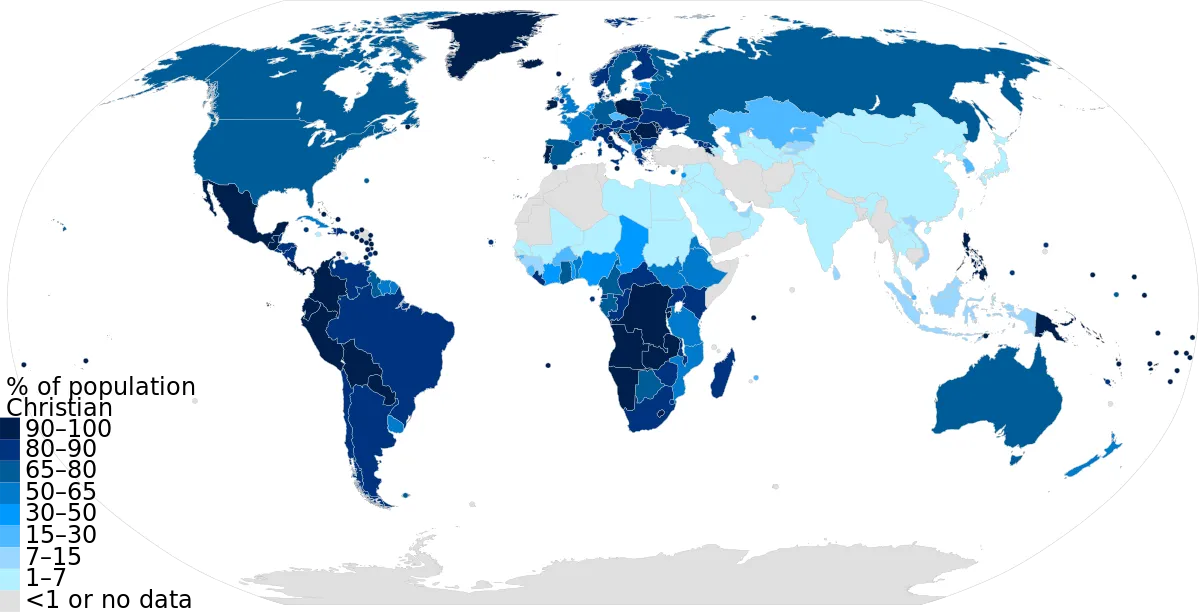What Percentage Of The World Population Is Christian? A Statistical Look
With over 2.3 billion adherents globally, Christianity is the world’s largest religion. But exactly what percentage of the global population identifies as Christian? And how is Christianity’s share of world population changing over time?
If you’re looking for the latest data on Christianity’s worldwide demographics, you’ve come to the right place. In this comprehensive statistical overview, we’ll examine Christianity’s global population percentage and regional distribution.
If you’re short on time, here’s a quick answer: As of 2020, about 31% of the world’s 7.8 billion people identify as Christian.
By surveying reputable demographic studies and sources like the World Christian Encyclopedia and Pew Research Center, we’ll break down Christianity’s followers by region, country, tradition, and more.
We’ll also analyze trends and factors influencing growth and decline among the world’s Christian population. Whether you’re a researcher, student, or fellow Christian, this extensive look at the data will tell you everything you need to know about Christianity’s current and forecasted worldwide reach.
Christianity’s Share of World Population
Total Global Christian Population
Christianity is one of the world’s largest religions, with a significant number of followers spread across the globe. According to recent statistics, the total global Christian population stands at billions.
However, it is important to note that there are different denominations and branches within Christianity, each with its own distinct beliefs and practices.
Percentage of World that is Christian
Christianity comprises a substantial portion of the world’s population. On average, approximately 30% of the global population identifies as Christian. This means that nearly one in every three individuals worldwide follows the Christian faith.
The spread of Christianity can be attributed to its long history, missionary efforts, and the influence of European colonization in various parts of the world.
Christianity Compared to Other Religions
When comparing the size of Christianity to other major religions, it is evident that Christianity is the largest. Islam is the second-largest religion globally, with around 23% of the world’s population identifying as Muslim.
Hinduism and Buddhism also have significant followings, with approximately 15% and 7% of the world’s population respectively.
It is worth noting that these statistics are subject to change as populations grow, migrate, and religious landscapes evolve over time. To stay up-to-date with the latest statistics and trends, one can refer to reputable sources such as the Pew Research Center’s website (www.pewresearch.org) or the World Christian Database (www.worldchristiandatabase.org).
Geographic Distribution of Christians
Christianity is the world’s largest religion, with a significant portion of the global population identifying as Christians. The geographic distribution of Christians varies across continents and regions, with some areas having a higher concentration of Christians than others.
Christians by Continent and Region
Christianity has a wide global reach, with followers spread across every continent. According to recent statistics, the highest number of Christians can be found in the Americas, followed by Europe, Africa, Asia, and Oceania.
The Americas, which includes North and South America, have the highest concentration of Christians, accounting for approximately 37% of the global Christian population.
Within each continent, the distribution of Christians can vary significantly. For example, in Africa, Christianity is the dominant religion in many countries, with a large Christian population in countries like Nigeria, Ethiopia, and the Democratic Republic of Congo.
Similarly, in Asia, countries like the Philippines, South Korea, and India have substantial Christian populations.
Countries with the Largest Christian Populations
When looking at individual countries, there are several nations with the largest Christian populations. The United States has the highest number of Christians, with over 240 million followers. Brazil, Mexico, Russia, and the Philippines also have significant Christian populations.
It’s important to note that the percentage of Christians within a country can vary significantly. While the United States has a high number of Christians, they make up around 70% of the population. In contrast, countries like Brazil and the Philippines have a higher percentage of Christians, with approximately 90% and 86% of the population identifying as Christians, respectively.
Declining Share in Europe and North America
While Christianity has a strong presence in many parts of the world, the share of Christians in Europe and North America has been declining in recent years. This decline can be attributed to various factors, including a rise in secularism, changing cultural attitudes, and an increase in religious diversity.
In Europe, countries like the United Kingdom, France, and Germany have experienced a decline in the number of Christians. This shift is also evident in North America, where the United States and Canada have seen a decrease in the percentage of Christians.
It’s important to recognize that these trends do not necessarily indicate a decline in religious belief overall. Instead, they reflect the changing religious landscape and the emergence of new religious movements and beliefs.
For more information on the global distribution of Christians, you can visit Pew Research Center or WorldAtlas.
Demographics Within Christianity
Christianity, one of the world’s largest religions, has a diverse range of followers. In this section, we will explore the demographics within Christianity to gain a better understanding of its various branches and characteristics.
Catholic vs. Protestant vs. Orthodox
Christianity can be broadly divided into three main branches: Catholic, Protestant, and Orthodox. The Catholic Church, led by the Pope, is the largest Christian denomination, with over a billion adherents worldwide.
Protestantism, which emerged from the Reformation in the 16th century, encompasses a wide range of denominations such as Lutheran, Baptist, Methodist, and Presbyterian. Orthodox Christianity, prevalent in Eastern Europe and the Middle East, follows a different tradition and has its own hierarchy.
While Catholicism has the largest number of followers, Protestantism has seen significant growth in recent years. According to a study by the Pew Research Center, Protestants make up around 37% of global Christians, while Catholics account for 50%.
Orthodox Christians comprise approximately 12% of the Christian population.
Pentecostals and Charismatics
Within the Protestant tradition, there are various movements and groups that emphasize spiritual gifts, including speaking in tongues and divine healing. Pentecostalism and Charismatic Christianity are two such examples.
Pentecostals, who originated from the early 20th-century Azusa Street Revival in Los Angeles, focus on the Holy Spirit’s role in personal spiritual experiences. Charismatic Christians, on the other hand, can be found in various denominations and emphasize the continuation of spiritual gifts seen in the early church.
These movements have gained considerable popularity, especially in Africa, Latin America, and parts of Asia. According to a report by the Pew Research Center, around a quarter of the world’s Christians (approximately 26%) identify as either Pentecostal or Charismatic.
Ethnicity, Age, and Gender
Christianity is a global religion, encompassing followers from various ethnicities, age groups, and genders. While historically Christianity has been associated with Western countries, its center of gravity has shifted to the Global South.
Today, the majority of Christians reside in Africa, Asia, and Latin America.
When it comes to age, Christianity has a diverse demographic profile. Younger generations, particularly in Western countries, are more likely to be unaffiliated or identify as non-religious. However, in many parts of the world, Christianity continues to be a significant influence on the lives of young people.
Gender distribution within Christianity also varies. Women make up a majority of the Christian population globally, according to data from the Pew Research Center. This is particularly evident in Catholicism and Orthodox Christianity, where women play important roles in religious practices and leadership positions.
Factors Influencing Growth and Decline
Births vs. Deaths
One of the key factors influencing the growth or decline of the Christian population is the ratio between births and deaths within the Christian community. Like any other religious or cultural group, the number of Christians in the world is affected by the natural cycle of life.
If the number of births within the Christian community exceeds the number of deaths, then the population grows. Conversely, if the number of deaths surpasses the number of births, the population declines.
However, it’s important to note that this factor alone does not provide a complete picture of the overall growth or decline of Christianity.
Conversion and Secularism
Conversion plays a significant role in shaping the Christian population. As individuals convert to Christianity, the overall number of Christians increases. Conversion can occur through personal experiences, evangelism efforts, or simply a change in religious beliefs.
On the other hand, secularism and the rise of non-religious or atheistic beliefs can lead to a decline in the Christian population. Factors such as education, cultural shifts, and changing societal norms can influence individuals to abandon their religious affiliations.
It’s important to consider the interplay between conversion and secularism when examining the growth and decline of Christianity worldwide.
Persecution and Violence
Another factor that can impact the growth or decline of the Christian population is persecution and violence. In certain parts of the world, Christians face discrimination, oppression, and even violence due to their religious beliefs.
This can result in forced conversions, displacement, or even death. Such hostile conditions can lead to a decline in the Christian population in those specific regions. It is crucial to acknowledge the challenges faced by Christians in various parts of the world and the impact it has on the overall growth of Christianity.
Conclusion
In conclusion, Christianity remains the world’s largest religion as of 2020, representing almost one-third of the global population. However its share is expected to decline somewhat by 2050, mainly due to falling membership in Europe.
While trends like secularism present challenges, Christianity continues to grow in the developing world through a combination of births, conversions, and migration. By understanding Christianity’s current worldwide reach and demographic trends, we gain valuable perspective on its future and our role in fulfilling the Great Commission.







